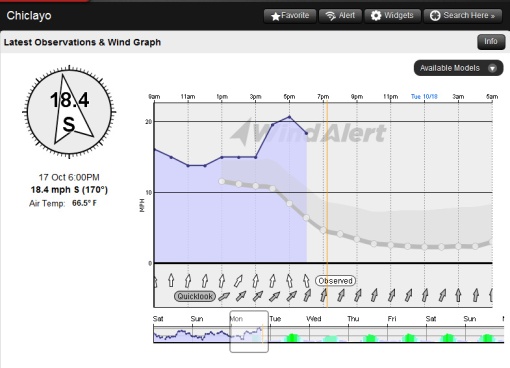I have been asked many questions about predicting the weather and swell by competitors attending the KSP wave kiting event here in Pacasmayo. The following is an attempt to answer those questions. The information and advice is based off realtime observations, watching the weather, talking to locals and reading forecasts over the last 2 months. If anyone can provide further insight into wind forecasting in Peru, I am interested in hearing from you. Please leave a message in the comments section if you have something to say or if this post has helped you in some way.
One of the challenges about kitesurfing in a new place, is being able to read the weather like a local. I really try to understand how accurate weather forecasting is in a particular area. The long-term Peruvian wind forecasts are probably the worst I have encountered in the last 7 months of travelling to France, Sardinia, Brazil and Morocco. I almost didn’t come to Pacasmayo because of low wind forecasts , but have been pleasantly surprised that there is usually 12- 25 knots if the sun is shining.
Because the waves in Peru often originate from such a long distance (15-20 sec period), wave forecasting is usually predictable a week out. Locals I have talked to look more at the swell period (15 sec+) rather than height to predict when the good swell will arrive. Magic Seaweed or Windguru are both reliable sites for wave forecasting.
The most reliable real-time source of wind information is the weather sensor in Chiclayo. This sensor provides a good indication of what is happening in Pacasmayo, despite being 50km away and inland. Wind Alert provides the easiest to understand wind stats and historical data from this sensor. If you want to see the raw data it can also be found on the NOAA website (select Peru and Chiclayo). Dewpoint and temperature are the most interesting as explained below.
Wind forecasting in Peru is so erratic that I have given up trusting the long-range forecasts. Predictwind and Windguru are, however, your best sources of information and are usually more accurate on the day, providing the sun is shining. All the sites I have been following are particularly poor at predicting the cloud cover which might account for the erratic forecasts.
In Pacasmayo the wind blows more cross-shore in the morning and early afternoon swings to more cross off. The time at which the wind swings and peaks, can vary anywhere between 1-5pm. Often the best sessions are late afternoon after the wind has swung more cross off .
The following 5 sites are worth looking at;
Magicseaweed- http://magicseaweed.com/Pacasmayo-Surf-Report/3289/
Look for the high period days of 15 seconds or more.
Windalert- http://windalert.com/en-us/Search/SpotInfo.aspx?spotid=16193
Good for real-time and historical information, but don’t trust the forecasts. Look for the wind angle to be 180 or less and 20mph+ for a good session. Wind becomes more cross offshore and it’s easier to get upwind at angles of 180 or less.
Windguru- http://www.windguru.cz/int/index.php?sc=52627
Add roughly 30% or more onto figures that Windguru predicts. If the day is cloudy then the raw figures will be correct and it is time to go surfing instead of kiting. Any swell over 2-3 m with a 15+ second period will be the longest rides of your life!
NOAA- http://weather.noaa.gov/weather/current/SPHI.html
Good for real-time wind, temperature and dew point readings. For those that want to get more technical and detailed view of what is happening, this is your source. Dew point is critical when it comes to forecasting fog that is likely to kill the wind. Fog is likely when the surface air temperature and dew point temperature are the same. Dew point is however different from humidity as this article explains.
Predictwind- http://www.predictwind.com/
PredictWind is one of my favorite sites because it uses two independent weather models to predict the weather. Comparing the PredictWind forecasts (GFS or CMC) can give you confidence in the forecast. If CMC and GFS models are showing the same numbers then the forecast is more reliable.













